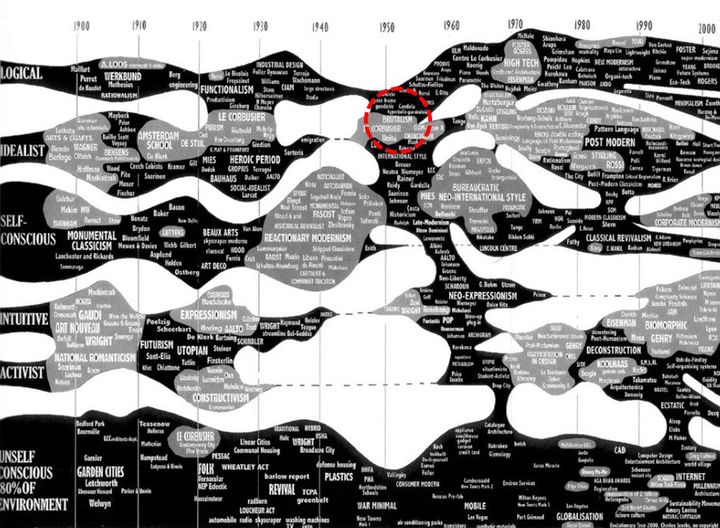On architectural pigeonholing. “As soon as you label a concept, you change how people perceive it.”

Metro station, Washington, DC. “Brutalist,” “Modernist,” “Postmodernist,” “Classical,” and/or “Roman”?
Last week in Washington, DC, DocomomoDC hosted “Rediscovering Brutalism,” a lecture by architect Michael Kubo followed by a walking tour of local examples, including multiple stations of the Washington Metro. Funny thing, though: Kubo doesn’t think the Metro is Brutalist.
“The Brutalist label doesn't really apply to the DC metro (or indeed to many buildings that are given that moniker),” he tells me. In his 2015 book, Heroic: Concrete Architecture and the New Boston, a reassessment of monumental concrete buildings from the mid-century, he and his co-authors, Mark Pasnik and Chris Grimley, lament the frequent use of the term as, in Kubo’s words, “simply a descriptor for buildings of that era that were built in concrete, regardless of their specific characteristics.”
Yet, this Spring several Washington-based architects and critics protested the painting of one Metro station by claiming the act defiled “the cardinal rule of Brutalism”—exposed concrete, according to them, although important examples include painted concrete, as well as other materials. (Just yesterday, the New Yorker featured the metal-clad Citicorp Tower as a “Brutalist masterpiece.”) As I wrote in July, the Metro’s architecture, designed by Harry Weese in the mid-60s, does include exposed concrete but otherwise strikes me as perhaps the opposite of Brutalism: light, not heavy; quiet, not imposing; clear spatial organization, not complex; efficiently structured, not over-designed; etc. Kubo agrees: “In my view, the DC metro has less to do with the self-described ethos of New Brutalism … and more to do with a Roman sense of scale and grandeur.” Even the use of concrete doesn’t seem perfectly “Brutalist,” as Pulitzer-winning critic Blair Kamin told me recently: “The Metro exhibits a use of the material that is more refined than raw. And rawness is a defining characteristic of the style.”
Others who agree include Harry Weese’s biographer, a Metro historian, and several nationally recognized experts on Brutalism, as I wrote in the earlier article. Nevertheless, in the online debate that ensued after publication, many of the writers I cited continued to insist, generally without much explanation, that the shoe fits. Does painting the Metro stations significantly diminish the experience of these spaces, or does it simply violate some theoretical law, perpetrating “a crime against Brutalism,” as one critic has put it? In any case, among the Washington-area structures often labeled “Brutalist,” the Metro is by far the most acclaimed. Without it, few if any others hold up to similar historical scrutiny. For local Brutalism buffs, dropping the Metro from that canon would lose their crown jewel.

“Neoclassical” buildings. L: West Wing, National Gallery of Art, Washington, DC. R: The White House.
Why does any of this matter? Why should anyone care what labels we use for buildings?
“As soon as you label a concept, you change how people perceive it,” writes psychologist Adam Alter. He calls this “a sort of linguistic Heisenberg principle.” Architects’ language is notoriously disorienting, and the use of jargon isn’t just potentially confusing for audiences—it actually can both obscure and undermine the users’ purposes. For instance, as the term sustainability becomes more and more popular, its meaning appears to become more and more elusive, which can distract from the very goals it represents, as I pointed out last year: “In the absence of clear definitions, words risk losing meaning altogether or taking on negative associations.” In my July articles, I noted that Brutalism has such muddy meaning that the authors of Heroic call it “a rhetorical catastrophe.” Architectural historian Joan Ockman writes in the introduction to that book, “Perhaps no other twentieth-century architectural -ism has been such a moving target.”
“Brutalism isn't a very useful label for the Washington Metro or a whole host of other things,” Ockman tells me now. “At best stylistic designations are heuristic devices. At worst they are pigeonholes that restrict the play of meanings that gives architecture its richness.” This is exactly how the label diminishes the Metro, according to Washington architect Bill Gallagher, who worked with Weese for nearly a decade in the 70s and 80s and who has worked extensively with the DC Metro system: “The term Brutalism greatly reduces the image and the respect that the Washington Metro deserves,” he offers. “A single term such as this distracts from the essence of such a grand subway system.”

“Modernist” or “Postmodernist,” both or neither? Vietnam Veterans Memorial, Washington, DC.
The role of the critic or any public advocate for architecture—especially when interpreting the richest works, including Weese’s Metro—should be to help our audiences glimpse the full breadth and depth of the works we describe. An -ISM can help create a larger historical context, but when used as a quick shorthand it can make a work smaller, not larger. All great work resists such simple classification, and this is true of many of Washington’s best structures.
For example, the original, West Wing of the National Gallery of Art typically is described as “neoclassical,” an obvious designation, given its domed rotunda and Greco-Roman features. Yet, in some ways, the design is dramatically different from, say, the White House, another building with an Ionic pedimented portico. The latter, which began construction in the late 18th Century, drew from the Adam Style, then fashionable in England and meant to convey aristocratic refinement through staid proportions and decorative finery. By contrast, the National Gallery, designed by John Russell Pope and completed in 1941, is surprisingly austere—“almost modernist in its severity,” as architecture critic Paul Goldberger once described it. The sculptural play of light and shadow is essentially the opposite of the Adam Style’s infatuation with ornamented windows sitting primly on thin wall planes. This aspect of Pope’s masterpiece certainly influenced I.M. Pei’s later East Wing (1978), with its deep, shaded recesses. (Pei’s wing itself has been described as “Brutalist,” although it is clad in Tennessee limestone, to echo the original.) Every other “neoclassical” building in DC looks downright fussy in comparison. Using one term to refer to both the National Gallery and the White House is a rhetorical convenience that completely ignores their extensive dissimilarities.
Similarly, Maya Lin’s Vietnam Veterans Memorial is popularly understood as a strictly “Modernist” design. A decade ago, when the American Institute of Architects (AIA) published a ranking of 150 structures representing “American’s Favorite Architecture,” the landmark was widely recognized as “the only Modernist structure” in the top ten, and when its design was revealed in 1981, its spare form and materials sparked an intense controversy over “the role of modernism in public sculpture.” Certainly preexisting perceptions about modern art fueled the initial ire, with some referring to the design as “nihilist.” Eventually, even its detractors came to recognize its subtle, cathartic power, and it has become “something of a shrine.” The label “Modernist” focuses on the design’s simplicity, conveying nothing of the intricate symbolic relationships with its context, notably the Washington Monument and the Jefferson Memorial, let alone its intimate spatial and tactile experience. If labels must be used, a convincing argument has been made that the memorial is less “Modernist” than “Postmodernist,” not merely because of the era in which it was built, but because it restored a deep sense of humanism to public space, which monumental modern architecture often is perceived to lack. Brutalism has been characterized as representing “the erasure of the self,” which is possibly why it often populates dystopian films such as A Clockwork Orange.

Charles Jencks, evolution of 20th-Century architectural styles (2000). “Brutalism” is wedged in the fringes.
Likewise, it would surely confound some architects if I suddenly started insisting without explanation that the Washington Metro’s architecture is itself “Postmodernist.” Chronologically and thematically, however, the term isn’t incompatible: Weese began designing the Metro in 1966, the same year Postmodern architecture ignited with Robert Venturi’s Complexity and Contradiction in Architecture, and the first Metro stations opened in the late 70s and early 80s, by which point the movement was blazing. As I wrote in July, the Metro’s design, which the Commission of Fine Arts specifically requested to be “a dignified design in the ‘spirit of the classical style,’” emulates historical architecture as much as it establishes something new. Some see Weese in general as “a kind of Postmodernist ahead of his time, reviving arched windows, symmetry, and elemental classical forms in the mold of Louis Kahn and the Venturis.”
The traveling exhibition on Louis Kahn’s work, now on display in Philadelphia, makes a powerful case that his work “defies the common classifications of modernism or postmodernism,” and arguably all great work aligns more with Venturi’s idea of “both-and” instead of “either-or.” We tend to think of historical styles in binary terms: buildings either do or do not belong in these categories. “The more -ISMs, the more schisms,” quips Arthur Goldwag. Yet, as architectural historian Charles Jencks illustrated in 2000, stylistic -ISMs tend to ebb and flow with blurrier boundaries. (Incidentally, Brutalism appears as a blip on the historical radar.) Fans of Weese’s Metro might more persuasively advocate for its preservation if they portrayed it in the most expansive terms—as a masterwork that resists fitting neatly into one bucket or another. Which is more likely to be treasured: a work of general cultural significance, or a period piece confined to an architectural style that is historically unpopular, even if it that style is making a comeback?
